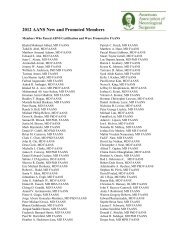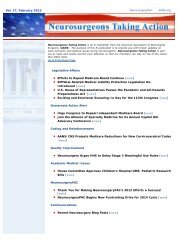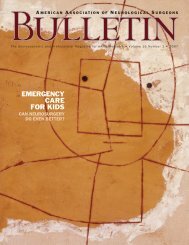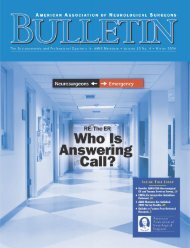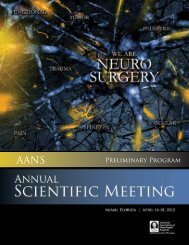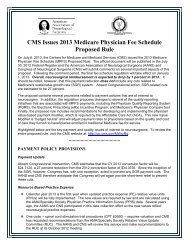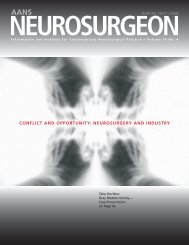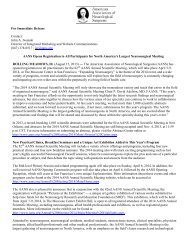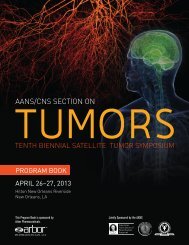view PDF - American Association of Neurological Surgeons
view PDF - American Association of Neurological Surgeons
view PDF - American Association of Neurological Surgeons
Create successful ePaper yourself
Turn your PDF publications into a flip-book with our unique Google optimized e-Paper software.
G OVERNANCE<br />
W. BEN BLACKETT,MD,JD,AND RUSSELL M. PELTON,JD<br />
Two Disciplinary Actions Announced<br />
AANS Board Approves Four PCC Recommendations<br />
At its meeting April 21 in San Francisco,<br />
the AANS Board <strong>of</strong> Directors<br />
approved the recommendation <strong>of</strong><br />
the Pr<strong>of</strong>essional Conduct Committee<br />
that four members be disciplined for<br />
unpr<strong>of</strong>essional conduct while testifying as<br />
expert witnesses in medical malpractice<br />
lawsuits. Two <strong>of</strong> those disciplinary actions,<br />
an expulsion and a six-month suspension <strong>of</strong><br />
membership, are being appealed to the general<br />
membership <strong>of</strong> the AANS. The two disciplinary<br />
actions that are not being<br />
appealed are summarized below.<br />
Edwin R. Buster, MD<br />
In the underlying malpractice litigation, a<br />
53-year-old man who experienced sudden<br />
nontraumatic onset <strong>of</strong> back pain, sense <strong>of</strong><br />
leg heaviness, and leg pain was admitted to<br />
a hospital through the emergency room in<br />
January <strong>of</strong> 2000. The admitting neurologist<br />
ordered that vital signs and neurological<br />
evaluations be obtained every four<br />
hours by the nursing staff during the night.<br />
When the neurologist examined his<br />
patient the next morning on rounds, he<br />
found him to be densely paraparetic/paraplegic.<br />
The ordered neurological checks<br />
had not been documented and apparently<br />
had not been performed during the night.<br />
An emergency MRI <strong>of</strong> the thoracic and<br />
lumbar spine demonstrated a large leftsided<br />
disc herniation with cord compression<br />
at T8–9. A neurosurgeon was then<br />
consulted and performed an emergency<br />
decompression with left posterolateral<br />
excision <strong>of</strong> the herniated disc at T8–9. The<br />
patient gradually improved from his essentially<br />
paraplegic state to a paraparesis with<br />
neurogenic bladder.<br />
The patient sued the hospital, the nurse<br />
who had been on duty the night <strong>of</strong> the<br />
patient’s deterioration, and the neurosurgeon.<br />
The neurosurgical expert witness for<br />
the plaintiff testified to the hospital’s negligence<br />
but was not at all critical <strong>of</strong> the surgery<br />
for removal <strong>of</strong> the thoracic disc<br />
herniation. Dr. Buster, the defense medical<br />
expert for the hospital, testified in his discovery<br />
deposition that the failure <strong>of</strong> the<br />
ABOUT THE AANS PROFESSIONAL CONDUCT PROGRAM<br />
The AANS Pr<strong>of</strong>essional Conduct Committee evaluates complaints by one or more AANS<br />
members about another member or members and makes recommendations to the Board<br />
<strong>of</strong> Directors. Established in 1982, the PCC has served as a model for other pr<strong>of</strong>essional<br />
associations to structure and adopt similar pr<strong>of</strong>essional conduct programs. In June <strong>of</strong><br />
2001, the AANS Pr<strong>of</strong>essional Conduct Committee’s work was examined by the 7th Circuit<br />
Court <strong>of</strong> Appeals in a landmark case for pr<strong>of</strong>essional associations, Austin v. AANS. This<br />
opinion strongly supported the AANS Pr<strong>of</strong>essional Conduct Program and the importance<br />
to a pr<strong>of</strong>essional association <strong>of</strong> having an internal mechanism for self-regulation. The<br />
program also received an honor roll designation from the <strong>American</strong> Society <strong>of</strong> <strong>Association</strong><br />
Executives in 2002.<br />
The AANS rules for expert witness testimony are reprinted on page 37. These rules,<br />
the AANS Code <strong>of</strong> Ethics and more information related to association governance are<br />
available online at www.aans.org/about in the Governance and Leadership area.<br />
nursing staff to check vital signs and neurological<br />
function as ordered by the admitting<br />
neurologist did not fall below the<br />
acceptable standard <strong>of</strong> nursing care. Dr.<br />
Buster further testified that the surgical<br />
procedure was inappropriate and that the<br />
defendant neurosurgeon could have been<br />
“up to 50 percent responsible” for the<br />
patient’s resulting neurological deficit.<br />
During the Pr<strong>of</strong>essional Conduct Committee<br />
hearing, Dr. Buster stated that he<br />
had not thoroughly re<strong>view</strong>ed the nursing<br />
records prior to testifying in his deposition<br />
and that “looking back on it now” the standard<br />
<strong>of</strong> proper nursing care was not met.<br />
The Pr<strong>of</strong>essional Conduct Committee<br />
concluded that Dr. Buster’s testimony as a<br />
defense expert witness for the hospital<br />
consisted <strong>of</strong> improper advocacy in denying<br />
negligence by the hospital and in misrepresenting<br />
the range <strong>of</strong> surgical standards<br />
for excising thoracic disc herniations in an<br />
attempt to shift responsibility for the neurological<br />
deficits from the hospital to the<br />
treating neurological surgeon. The AANS<br />
Board <strong>of</strong> Directors agreed with the PCC’s<br />
findings and voted to suspend Dr. Buster’s<br />
membership in the AANS for one year.<br />
William H. Bloom, MD<br />
The underlying lawsuit in this case involved<br />
a 44-year-old man who complained <strong>of</strong> a<br />
history <strong>of</strong> right arm pain with numbness in<br />
his right index and middle fingers. The<br />
problem reportedly began when he awakened<br />
one morning with scapular pain that<br />
was soon followed by right arm pain. A CT<br />
scan showed foraminal narrowing with<br />
spondylosis and some spinal stenosis.<br />
Approximately one month later the patient<br />
reported having experienced some “electric<br />
shock” sensations in his left arm. Surgery<br />
was carried out in the lateral position with<br />
bilateral laminectomies at C4, C5, C6 and<br />
C7. The operative note describes decom-<br />
36 Vol. 15, No. 2 • 2006 • AANS Bulletin



